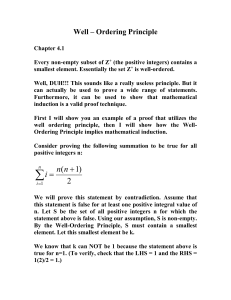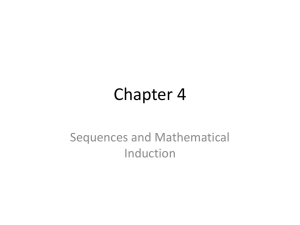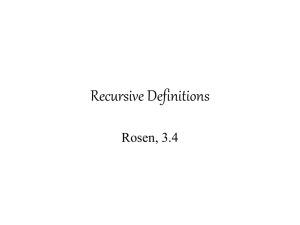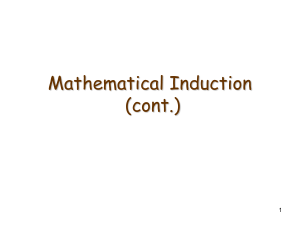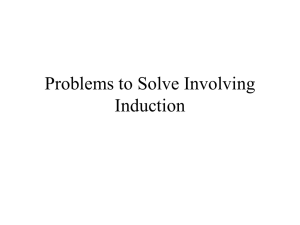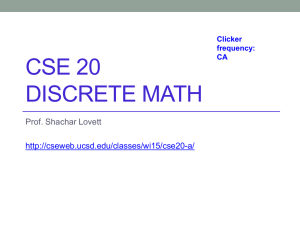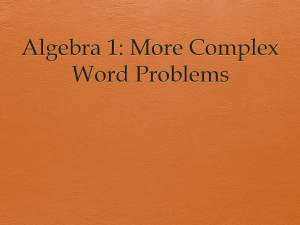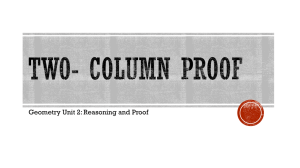FP1 Chapter 6 - By Dr J Frost
advertisement
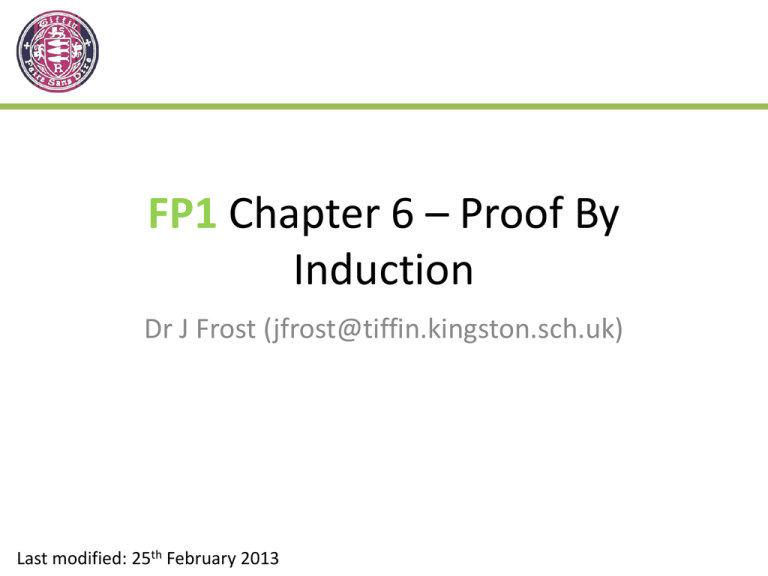
FP1 Chapter 6 – Proof By Induction Dr J Frost (jfrost@tiffin.kingston.sch.uk) Last modified: 25th February 2013 What is Proof by Induction? We tend to use proof by induction whenever we want to show some property holds for all integers (usually positive). Example Show that 𝑛 𝑖=1 𝑖 1 = 2 𝑛 𝑛 + 1 for all 𝑛 ∈ ℕ. Showing it’s true for a few values of 𝑛 is not a proof. We need to show it’s true for ALL values of 𝑛. If it’s true for 𝑛 = 1, it must be true for 𝑛 = 2. 𝒏=𝟏 𝒏=𝟐 Suppose we could prove the above is true for the first value of 𝑛, i.e. 𝑛 = 1. 𝒏=𝟑 If it’s true for 𝑛 = 3, it must be true for 𝑛 = 4. 𝒏=𝟒 𝒏=𝟓 … If it’s true for 𝑛 = 2, it must be true for 𝑛 = 3. And so on. Hence the statement must be true for all 𝑛. Suppose that if we assumed it’s true for 𝑛 = 𝑘, then we could prove it’s true for 𝑛 = 𝑘 + 1. Then: Chapter Overview We will use Proof of Induction for 4 different types of proof: 𝑛 𝑖=1 𝑖 1 1 Summation Proofs Show that 2 Divisibility Proofs Prove that 𝑛3 − 7𝑛 + 9 is divisible by 3 for all 𝑛 ∈ ℤ+ . 3 Recurrence Relation Proofs Given that 𝑢𝑛+1 = 3𝑢𝑛 + 4, prove that 𝑢𝑛 = 3𝑛 − 2 Matrix Proofs 1 Prove that 0 4 = 2 𝑛 𝑛 + 1 for all 𝑛 ∈ ℕ. −1 3 𝑛 1 = 0 𝑢1 = 1, 1 − 2𝑛 for all 𝑛 ∈ ℤ+ . 𝑛 2 Bro Tip: Recall that ℤ is the set of all integers, and ℤ+ is the set of all positive integers. Thus ℕ = ℤ+ . The Four Steps of Induction For all these types the process of proof is the same: ! Proof by induction: Step 1: Basis: Prove the general statement is true for 𝑛 = 1. Step 2: Assumption: Assume the general statement is true for 𝑛 = 𝑘. Step 3: Inductive: Show that the general statement is then true for 𝑛 = 𝑘 + 1. Step 4: Conclusion: The general statement is then true for all positive integers 𝑛. (Step 1 is commonly known as the ‘base case’ and Step 3 as the ‘inductive case’) Type 1: Summation Proofs Prove the general statement is true for 𝑛 = 1. Assume the general statement is true for 𝑛 = 𝑘. Show that the general statement is then true for 𝑛 = 𝑘 + 1. The general statement is then true for all positive integers 𝑛. Step 1: Basis: Step 2: Assumption: Step 3: Inductive: Step 4: Conclusion: Show that 𝑛 𝑖=1(2𝑖 − 1) = 𝑛2 for all 𝑛 ∈ ℕ. 1 Basis Step When 𝑛 = 1, 𝐿𝐻𝑆 = 1𝑖=1 2𝑖 − 1 = 2 1 − 1 = 1 𝑅𝐻𝑆 = 12 = 1. 𝐿𝐻𝑆 = 𝑅𝐻𝑆 so?summation true for 𝑛 = 1. 2 Assumption Assume summation true for 𝑛 = 𝑘. ? So 𝑘𝑖=1(2𝑖 − 1) = 𝑘 2 3 Inductive When 𝑛 = 𝑘 + 1: 𝑘+1 𝑘 2𝑖 − 1 = 𝑖=1 2𝑖 − 1 𝑖=1 = 𝑘 2 + 2𝑘 + 1 = 𝑘+1 2 Hence true when 𝑛 = 𝑘 + 1. 4 Conclusion ? + 2 𝑘+1 −1 As result is true for 𝑛 = 1, this implies true for all positive integers ? and hence true by induction. More on the ‘Conclusion Step’ “As result is true for 𝑛 = 1, this implies true for all positive integers and hence true by induction.” I lifted this straight from a mark scheme, hence use this exact wording! The mark scheme specifically says: (For method mark) Any 3 of these seen anywhere in the proof: • “true for 𝒏 = 𝟏” • “assume true for 𝒏 = 𝒌” • “true for 𝒏 = 𝒌 + 𝟏” • “true for all 𝒏/positive integers” Test Your Understanding Edexcel FP1 Jan 2010 ? Exercise 6A All questions except Q2. Type 2: Divisibility Proofs Step 1: Basis: Step 2: Assumption: Step 3: Inductive: Step 4: Conclusion: Prove the general statement is true for 𝑛 = 1. Assume the general statement is true for 𝑛 = 𝑘. Show that the general statement is then true for 𝑛 = 𝑘 + 1. The general statement is then true for all positive integers 𝑛. Prove by induction that 32𝑛 + 11 is divisible by 4 for all positive integers 𝑛. 1 Basis Step Let 𝑓 𝑛 = 32𝑛 + 11, where 𝑛 ∈ ℤ+ . 𝑓 1 = 32 + 11 = 20 which is divisible ? by 4. 2 Assumption Assume that for 𝑛 = 𝑘, 𝑓 𝑘 = 32𝑘 + 11 is divisible by 4 for 𝑘 ∈ ℤ+ . 3 Inductive ? 𝑓 𝑘 + 1 = 32 𝑘+1 + 11 Bro Tip: Putting in terms of 32𝑘 allows us to better compare with the assumption case = 32𝑘 ⋅ 32 + 11 since the power is now the same. = 9 32𝑘 + 11 ∴ 𝑓 𝑘 + 1 − 𝑓 𝑘 = 9 32𝑘 + 11 − 32𝑘 + 11 =8 4 Conclusion 32𝑘 =4 2 32𝑘 ? Bro Tip: For divisibility proofs, find the difference, and show that’s divisible by what we’re interested in. This is similar to how for summation proofs we isolated the difference in the sum relative to the previous summation. ∴ 𝑓 𝑘 + 1 = 𝑓 𝑘 + 4 2 32𝑘 Therefore 𝑓(𝑛) is divisible by 4 when 𝑛 = 𝑘 + 1. Since true for 𝑛 = 1 and if true for 𝑛 = 𝑘, true for 𝑛 = 𝑘 + 1 for all 𝑘 ? ∈ ℤ+ , therefore true for all integers. Test Your Understanding Step 1: Basis: Step 2: Assumption: Step 3: Inductive: Step 4: Conclusion: Prove the general statement is true for 𝑛 = 1. Assume the general statement is true for 𝑛 = 𝑘. Show that the general statement is then true for 𝑛 = 𝑘 + 1. The general statement is then true for all positive integers 𝑛. Prove by induction that 𝑛3 − 7𝑛 + 9 is divisible by 3 for all positive integers 𝑛. 1 Basis Step Let 𝑓 𝑛 = 𝑛3 − 7𝑛 + 9, where 𝑛 ∈ ℤ+ . 𝑓 1 = 3 which is divisible by 3. ? 2 Assumption Assume that for 𝑛 = 𝑘, 𝑓 𝑘 = 𝑘 3 − 7𝑘 + 9 is divisible by 3 for 𝑘 ? ∈ ℤ+ . 𝑓 𝑘+1 = 𝑘+1 3−7 𝑘+1 +9 =⋯ = 𝑘 3 + 3𝑘 2 − 4𝑘 + 3 ∴ 𝑓 𝑘 + 1 − 𝑓 𝑘 = ⋯ = 3 𝑘2 ? +𝑘−2 ∴ 𝑓 𝑘 + 1 = 𝑓 𝑘 + 3 𝑘2 + 𝑘 − 2 Therefore 𝑓(𝑛) is divisible by 3 when 𝑛 = 𝑘 + 1. 3 Inductive 4 Conclusion Since true for 𝑛 = 1 and if true for 𝑛 = 𝑘, true for 𝑛 = 𝑘 + 1 for all 𝑘 ? by induction. ∈ ℤ+ , therefore true for all integers Exercise 6B Page 130. All questions. Type 3: Recurrence Relation Proofs Step 1: Basis: Step 2: Assumption: Step 3: Inductive: Step 4: Conclusion: Prove the general statement is true for 𝑛 = 1. Assume the general statement is true for 𝑛 = 𝑘. Show that the general statement is then true for 𝑛 = 𝑘 + 1. The general statement is then true for all positive integers 𝑛. Notice that we’re trying to prove a position-toterm formula from a term-to-term one. Given that 𝑢𝑛+1 = 3𝑢𝑛 + 4 and 𝑢1 = 1, prove by induction that 𝑢𝑛 = 3𝑛 − 2 1 Basis Step When 𝑛 = 1, 𝑢1 = 31 − 2 = 1 as given. ? IMPORTANT NOTE: The textbook gets this wrong (bottom of Page 131), saying that 𝒖𝟐 is required. I checked a mark scheme – it isn’t. 2 Assumption Assume that for 𝑛 = 𝑘, 𝑢𝑘 = 3𝑘 − 2 is true for 𝑘 ∈ ℤ+ . 3 Inductive Then 𝑢𝑘+1 = 3𝑢𝑘 + 4 4 Conclusion Since true for 𝑛 = 1 and if true for 𝑛 = 𝑘, true for 𝑛 = 𝑘 + 1 for all 𝑘 ? ∈ ℤ+ , therefore true for all integers. ? = 3 3𝑘 − 2 + 4 = 3𝑘+1?− 6 + 4 = 3𝑘+1 − 2 This type of proof is slightly different to a summation proof, because we’re using some given statement (the recurrence) to prove another, whereas before we only had one statement. Test Your Understanding Edexcel FP1 Jan 2011 ? Recurrence Relations based on two previous terms Step 1: Basis: Step 2: Assumption: Step 3: Inductive: Step 4: Conclusion: Prove the general statement is true for 𝑛 = 1. Assume the general statement is true for 𝑛 = 𝑘. Show that the general statement is then true for 𝑛 = 𝑘 + 1. The general statement is then true for all positive integers 𝑛. Given that 𝑢𝑛+2 = 5𝑢𝑛+1 − 6𝑢𝑛 and 𝑢1 = 13, 𝑢2 = 35, prove by induction that 𝑢𝑛 = 2𝑛+1 + 3𝑛+1 1 Basis Step When 𝑛 = 1, 𝑢1 = 22 + 32 = 13 as given. When 𝑛 = 2, 𝑢2 = 23 + 33 = 35 as ? given. We have two base cases so had to check 2 terms! 2 Assumption Assume that for 𝑛 = 𝑘 and 𝑛 = 𝑘 + 1, 𝑢𝑘 = 2𝑘+1 + 3𝑘+1 and 𝑢𝑘+1 = 2𝑘+2 + 3𝑘+2 is true for 𝑘 ∈ ℤ+ . ? We need two previous instances of 3 Inductive Then 𝑢𝑘+2 = 5𝑢𝑘+1 − 6𝑢𝑘 = 5 2𝑘+1 + 3𝑘+1 − 6 2𝑘+1 + 3𝑘+1 ? =⋯ = 2𝑘+3 + 3𝑘+3 = 2𝑘+2+1 + 3𝑘+2+1 4 Conclusion Since true for 𝑛 = 1 and 𝑛 = 2 and if true for 𝑛 = 𝑘 and 𝑛 = 𝑘 + 1, true for 𝑛 = 𝑘 + 2 for all 𝑘 ∈ ℤ+ , ? therefore true for all integers. 𝑛 in our assumption case now. Exercise 6C Page 132. Q1, 3, 5, 7 Type 4: Matrix Proofs Step 1: Basis: Step 2: Assumption: Step 3: Inductive: Step 4: Conclusion: Prove the general statement is true for 𝑛 = 1. Assume the general statement is true for 𝑛 = 𝑘. Show that the general statement is then true for 𝑛 = 𝑘 + 1. The general statement is then true for all positive integers 𝑛. 1 Prove by induction that 0 1 Basis Step 2 Assumption 3 Inductive 4 Conclusion −1 3 𝑛 1 = 0 1 − 2𝑛 for all 𝑛 ∈ ℤ+ . 𝑛 2 1 −1 1 1 −1 When 𝑛 = 1, 𝐿𝐻𝑆 = = 0 3 0 2 1 1 −1 ? 𝑅𝐻𝑆 = 1 1 −12 = . As 𝐿𝐻𝑆 = 𝑅𝐻𝑆, true for 𝑛 = 1. 0 2 0 2 𝑘 1 −1 𝑘 1 1 − 2 Assume true 𝑛 = 𝑘, i.e. = 0 3 ? 0 2𝑘 When 𝑛 = 𝑘 + 1, 𝑘 1 −1 𝑘+1 1 −1 𝑘 1 −1 1 1 − 2 = = 0 3 0 3 0 3 0 2𝑘 𝑘+1 ? 1 1 − 2 =⋯= 𝑘+1 0 2 Therefore true when 𝑛 = 𝑘 + 1. 1 0 −1 3 Since true for 𝑛 = 1 and if true for 𝑛 = 𝑘, true for 𝑛 = 𝑘 + 1 for all 𝑘 ? by induction. ∈ ℤ+ , therefore true for all integers Test Your Understanding Step 1: Basis: Step 2: Assumption: Step 3: Inductive: Step 4: Conclusion: Prove the general statement is true for 𝑛 = 1. Assume the general statement is true for 𝑛 = 𝑘. Show that the general statement is then true for 𝑛 = 𝑘 + 1. The general statement is then true for all positive integers 𝑛. −2 9 Prove by induction that −1 4 1 Basis Step 2 Assumption 3 Inductive 4 Conclusion 𝑛 = −3𝑛 + 1 9𝑛 for all 𝑛 ∈ ℤ+ . −𝑛 3𝑛 + 1 −2 9 1 −2 9 When 𝑛 = 1, 𝐿𝐻𝑆 = = −1 4 −1 4 −3 + 1 9 −2 ? 9 𝑅𝐻𝑆 = = . As 𝐿𝐻𝑆 = 𝑅𝐻𝑆, true for 𝑛 = 1. −1 3+1 −1 4 −2 9 𝑘 −3𝑘 + 1 9𝑘 Assume true 𝑛 = 𝑘, i.e. = −𝑘 3𝑘 + 1 −1 4 ? When 𝑛 = 𝑘 + 1, −2 9 𝑘+1 −2 9 𝑘 −2 9 −3𝑘 + 1 9𝑘 −2 9 = = −𝑘 3𝑘 + 1 −1 4 −1 4 −1 4 −1 4 −3 ? 𝑘 + 1 + 1 9(𝑘 + 1) −3𝑘 − 2 9𝑘 + 9 =⋯= = −(𝑘 + 1) 3 𝑘+1 +1 −𝑘 − 1 3𝑘 + 4 Therefore true when 𝑛 = 𝑘 + 1. Since true for 𝑛 = 1 and if true for 𝑛 = 𝑘, true for 𝑛 = 𝑘 + 1 for all 𝑘 ? by induction. ∈ ℤ+ , therefore true for all integers Exercise 6D Page 134. All questions.
